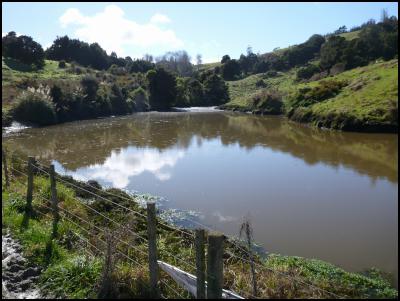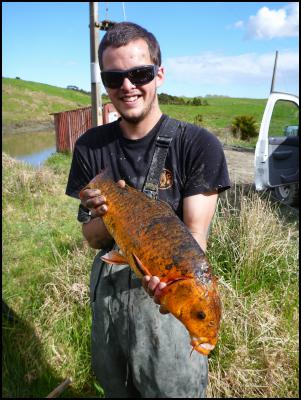Banned koi carp found in Northland
Date: 29 August, 2012
Banned koi carp
found in Northland

Biosecurity officials
are working to try to contain a large infestation of banned
koi carp - one of Australasia’s worst freshwater pest fish
- found in two Kaipara farm ponds.
Since their discovery
earlier this month by a farm worker, more than 100 koi have
been recovered form one of the ponds and destroyed in an
ongoing joint Northland Regional Council and Department of
Conservation operation.
Don McKenzie, the Northland Regional Council’s Biosecurity Senior Programme Manager, says as of today 104 koi – some more than half-a-metre long and weighing almost three kilogrammes – have been recovered from the large Pahi dairy farm, near Paparoa.
Just how the banned fish came to be in the two large farm ponds is still being investigated, but initial inquiries indicate they have been there for several years and before it was purchased by its current owner. Both the owner and farm staff had been extremely co-operative and the council was grateful for this.
Mr McKenzie says koi are an ornamental strain of the common carp (Cyprinus carpio) native to Asia and Europe, but are legally classed as both an unwanted organism and noxious species in this country. They are thought to have been accidentally imported into New Zealand more than 40 years ago as part of a goldfish consignment.
He says the fish’s feeding habits and the havoc it can wreak upon the environment make it well-deserving of its banned status and reputation as one of Australasia’s worst freshwater pest fish.
“Koi feed like a vacuum cleaner sucking up a wide
range of food, including insects, fish eggs, juvenile fish
of other species and a diverse range of plants and other
organic matter.

When they feed they suck
up prey, but blow out what isn't wanted, stirring up the
bottom of ponds, lakes and rivers, muddying the water making
it unsuitable for swimming and drinking as well as
destroying native plant and fish habitat.”
Mr McKenzie
says aquatic plants are dislodged in the feeding process and
are unlikely to re-establish, with koi causing habitat loss
for plants, native fish, invertebrates and
waterfowl.
“Superficially, koi resemble goldfish but in
New Zealand they can grow much larger (up to 10kg and 75cm
long) and they also have two pairs of whisker-like feelers
at the corner of their mouth.”
Koi vary greatly in colour, often accompanied with irregular blotching of black, red, gold, orange or pearly white.
Mr McKenzie says a number of the fish caught in Pahi have been female with an autopsy revealing one 2.5kg fish alone had contained about 250 grams of eggs; roughly 100,000 potential offspring.
At this stage, he estimates the control operation has already cost about $10,000, including “much-appreciated” voluntary contributions of machinery and labour made by the property owner.
Mr McKenzie says officials have installed a series of nets across all the outflows from the ponds to prevent koi from escaping into a nearby small creek which flows into the Kaipara Harbour.
At this stage, there’s no indication any koi had escaped from the ponds previously, but given the ponds are prone to flooding in heavy rain events, that could not be ruled out.
He says with help from farm staff, one of the ponds is being slowly drained in an attempt to net and recover every koi in it. Water samples would also need to be taken to ensure there was no fish larvae or fry (juvenile fish) in it.
They would then repeat the netting process in the second, smaller pond, although it may not be possible to drain it because it was used to supply the farm’s stock water. Officials expect to spend up to another several months at the Pahi site in a bid to ensure all the koi were gone.
Mr McKenzie says koi can survive in very low oxygen levels, in areas where salt and freshwater meet and even out of water altogether for hours at a time.
“Over the years, we’re aware of several koi incursions in various parts of the region but to date all of these have been successfully contained or eradicated. We’re keen to continue to keep this very undesirable intruder out of our region. The Waikato is plagued with this fish and we’d been absolutely despairing if this fish became well-established here.”
Mr McKenzie says anyone sighting what they thought might be a koi in Northland should contact the regional council on (0800) 002 004 for advice.
Council staff would be happy to visit any landowner who suspected they had seen koi at no charge.
“We just want these fish gone.”
Meanwhile, he says it’s important not to confuse koi’s unwanted status with that of grass carp, which is used for aquatic weed control, is not harmful and is unable to breed naturally in New Zealand.
Information about koi is available from regional council offices, from its website via www.nrc.govt.nz/nasties or from the Department of Conservation website via: www.doc.govt.nz/conservation/threats-and-impacts/animal-pests/animal-pests-a-z/fish/facts/koi-carp/
ENDS


 Gordon Campbell: On What’s Wrong With The Treaty Principles Bill
Gordon Campbell: On What’s Wrong With The Treaty Principles Bill NZ National Party: National Acknowledges The Passing Of Hon Nikki Kaye
NZ National Party: National Acknowledges The Passing Of Hon Nikki Kaye Mana Mokopuna: Children And Young People Share Vital Insights On Healing From Family Violence And Sexual Violence In New Report
Mana Mokopuna: Children And Young People Share Vital Insights On Healing From Family Violence And Sexual Violence In New Report NZ Government: PM Marks One Year In Government
NZ Government: PM Marks One Year In Government Helen Clark Foundation: Helen Clark Foundation Calls For Political Action To Reduce The Prevalence Of Junk Food And Improve Health Outcomes
Helen Clark Foundation: Helen Clark Foundation Calls For Political Action To Reduce The Prevalence Of Junk Food And Improve Health Outcomes Justice Committee: Further Decisions About Submissions Process For The Principles Of The Treaty Of Waitangi Bill
Justice Committee: Further Decisions About Submissions Process For The Principles Of The Treaty Of Waitangi Bill Infrastructure New Zealand: Single Agency Needed To Coordinate Climate Adaptation And Recovery
Infrastructure New Zealand: Single Agency Needed To Coordinate Climate Adaptation And Recovery


